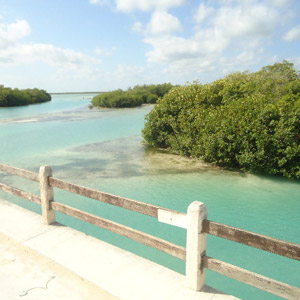Magazine | Voyages
Séjour ornithologique au Quintana Roo (Mexique) en avril 2003

Mangrove dans la réserve de la biosphère de Sian Ka’an, dans l’état mexicain de Quintana Roo.Photographie : Àlex / Wikimedia Commons
Introduction
L’état mexicain du Quintana Roo, occupant l’est de la péninsule du Yucatán, a été nommé ainsi d’après le poète Andres Quintana Roo. C’est sur la côte de cet état que sont arrivés la première fois les conquistadores en 1517. Le climat de la région est chaud et humide à l’intérieur des terres, mais une brise agréable souffle sur la côte. Les plus fortes précipitations ont lieu en été. La forêt tropicale occupe une grande surface, tout comme la mangrove et la savane. La vie marine est également très riche, grâce à la présence de seconde barrière coralliaire du monde. Le Quintano-Roo comprend différentes zones protégées : Siankaán, Holbox, El Eden, Puerto Morelos, Cozumel reefs et Isla Contoy, qui assurent une protection des espèces les plus menacées. L’amateur pourra observer une grande diversité d’espèces d’oiseaux lors d’un séjour d’une dizaine de jours dans l’un des hôtels de la côtd, comme nous le montre Guy Delcroix qui y a séjourné en avril 2003.
Les photos ont été réalisées à partir d’un caméscope numérique puis extraites à la volée à l’aide d’un logiciel de capture.
Abstract
The Mexican State of Quintana Roo is named after Andres Quintana Roo, Yucatan`s first poet. In a fateful paradox, this was the first landfall of the Spanish conquistadors (1517); but the last part of Mexico to be conquered. It was designated a federal territory on 1902, but it was not until 1974 that it became a fully-fledged Mexican state, just in time to build Cancun.
Quintana Roo has a population of almost 1 million people living in several cities (Cancun, Chetumal, Cozumel, Carrillo Puerto, Isla Mujers and Playa Del Carmen); and many little Mayan towns throughout the state. The climate is hot and humid inland but ocean breezes cool the coastline. It rains in the summer.
The vegetation is mainly low and medium jungle, with a big section of mangroves and some savannah. The whole of the state is rich in both marine and land wildlife; there’s a part of the second largest coral reef in the world and a big Biosphere reserve (Siankaán) where many animals and plants find shelter from development. The weather was far from ideal for birding – it was generally very hot and unbearably humid, especially in the forest areas.
Guy Delcroix has stayed a few days around Akuma in April 2003, and he has twitched a good variety of tropical birds.
Poursuivez la lecture de cet article, en vous abonnant dès maintenant !
Découvrez les Archives d’Ornithomedia.com
Pour seulement 10,00 €TTC/an (ou 6,00 € les 6 mois)
Profitez de plusieurs centaines d’articles en accès illimité et sans aucun engagement.
Compléments
À lire aussi sur Ornithomedia.com
- Observer les oiseaux dans l’état d’Oaxaca (Mexique)
- À la recherche du Pic impérial au Mexique en 2005
Ouvrages recommandés
- Birds of Mexico and Central America de Ber van Perlo (3 juillet 2006)
- Where to Watch Birds in Mexico de Steve Howell et Sophie Webb (Illustrations)
- Guide to the Birds of Mexico and Northern Central America de Steve N. G. Howell et Sophie Webb
- Where to Watch Birds in Central America, Mexico, and the Caribbean de Nigel Wheatley





Aucun commentaire sur ce sujet
Participer à la discussion !